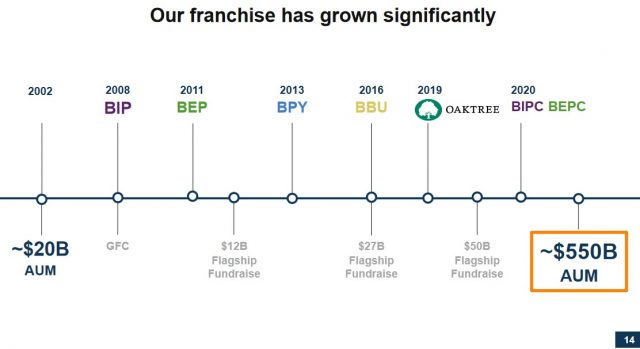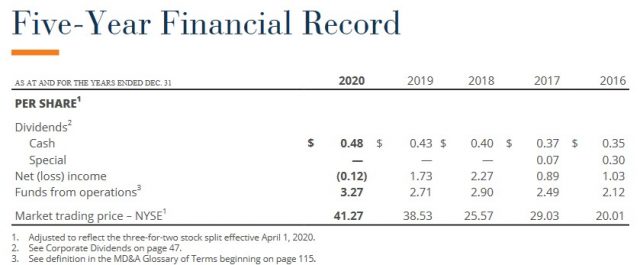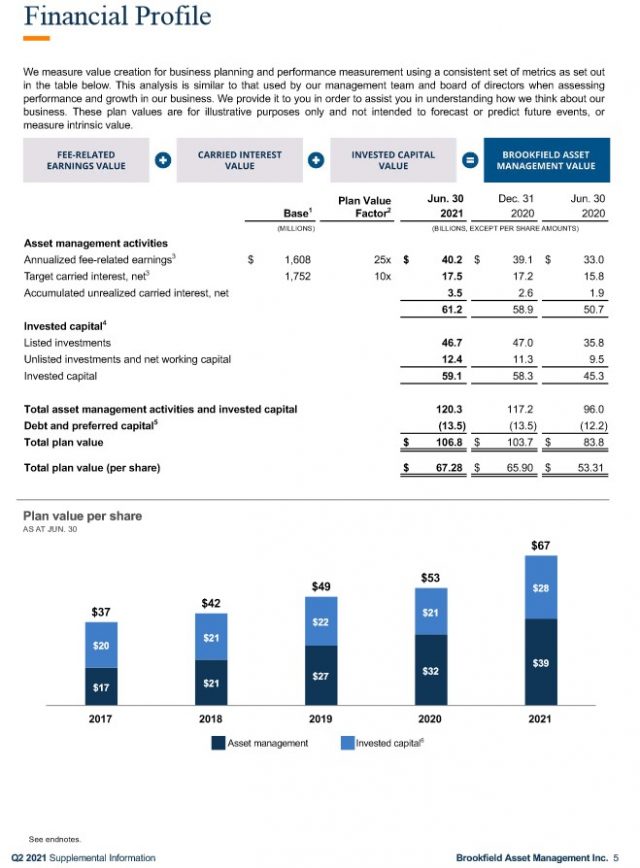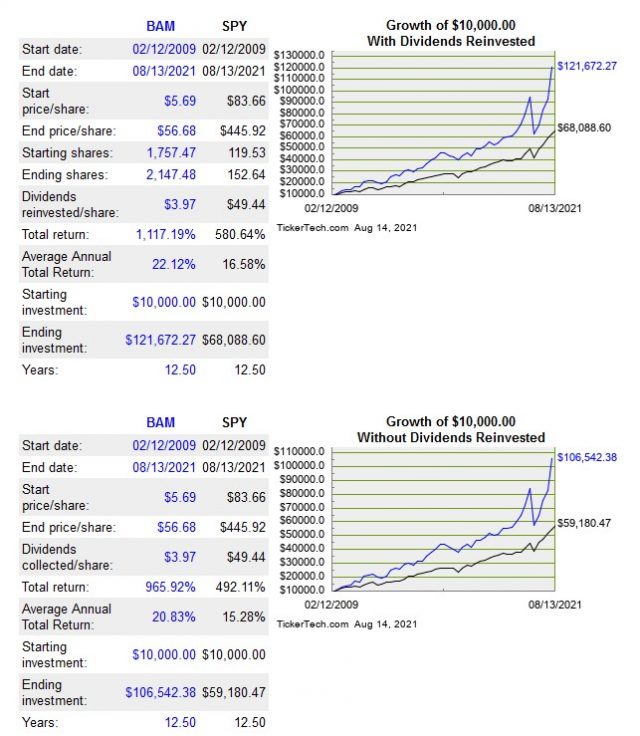Contents
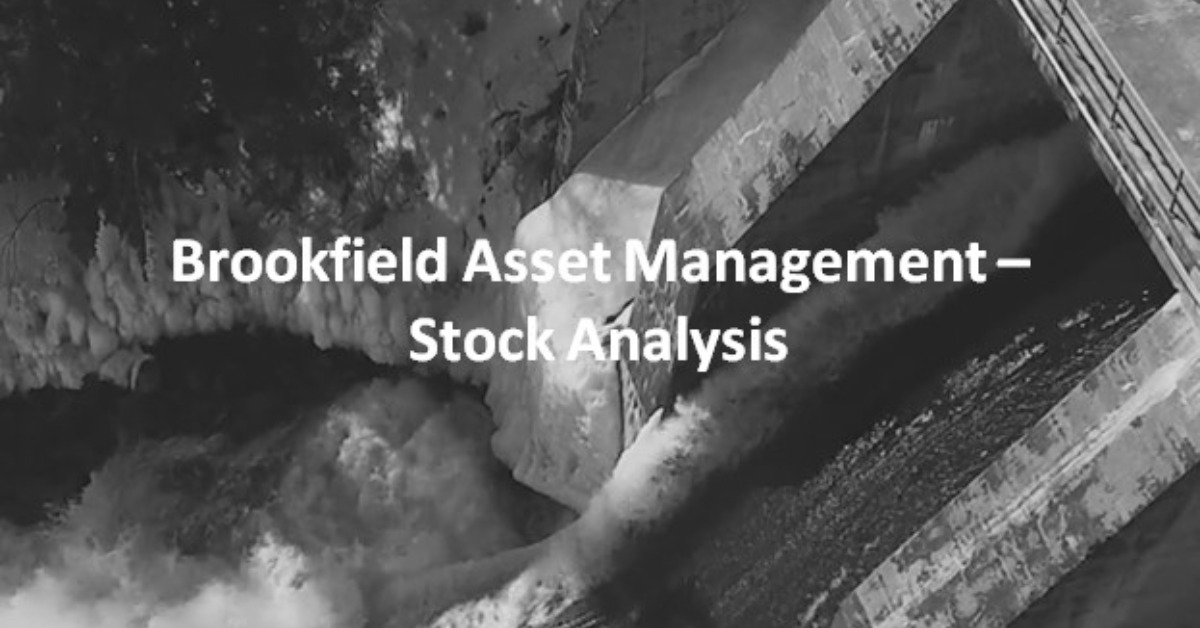
Brookfield Asset Management (BAM) released Q2 and YTD results on August 12, 2021. Based on this stock analysis, I deem BAM's current valuation to be attractive.
NOTE: Brookfield Asset Management is listed on the TSX (BAM-a) and the NYSE (BAM).
The company is authorized to issue an unlimited number of Class A Limited Voting Shares ('Class A shares') and 85,120 Class B Limited Voting Shares ('Class B shares'); insiders hold the Class B shares.
BAM conducts more of its operations in USD than any other single currency. Given this, the USD dollar is BAM's functional and reporting currency for purposes of preparing consolidated financial statements.
Brookfield Asset Management - Stock Analysis - Business Overview
When BAM held its 2020 Investor Day on September 24, 2020, it reported ~$550B of Assets Under Management (AUM). We see, however, that BAM has $600+B in AUM just a few months after Investor Day!
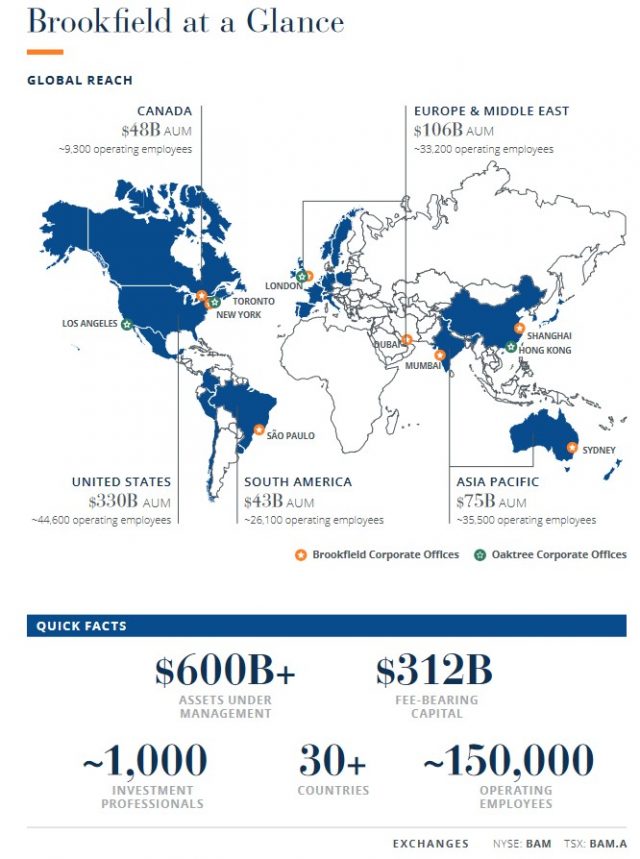
BAM's primary goal is to earn a 12-15% return compounded over the long term while always maintaining excess capital to support ongoing operations. The target gross returns for its various funds are typically 20%+ for opportunistic funds, 13% to 15% for value add funds, and 12% to 15% for credit and core funds.
A comprehensive overview of the company is found at the beginning of its FY2020 Annual Report.
While much has changed since BAM's 2020 Investor Day, its Investor Presentation provides a good high-level overview of the company. BAM's 2021 Investor Day is to be held on September 20 and 21.
A key element of BAM's growth is expanding the size and depth of its existing client relationships while also adding new relationships. Five years ago, BAM had 425 clients who were in 1.8 of BAM's funds on average. BAM now has 2,000 clients, each of whom invests in 2.1 funds on average. The reason for BAM's success is that it performs well and treats clients well.
Over the years, BAM's fundraising efforts have focused on the largest institutions across North America, Asia, the Middle East and Europe. While there is significant growth potential in this area, BAM is also focusing on new fundraising channels such as private wealth, mid-market investors and other wealth pools such as insurance.
Brookfield Asset Management - Stock Analysis - Historical Investment Returns
BAM is different from most operating companies in several aspects. Perhaps the most noticeable aspect is that BAM raises pools of funds from clients in the tens of billions of dollars. It then deploys these funds thus resulting in multiple billion-dollar acquisitions annually; the size of these acquisitions has grown significantly over the years.
BAM uses its expertise to improve the performance of the acquired companies with the intent of monetizing these assets as part of its capital recycling programs. These dispositions often generate large proceeds for clients, principal investment proceeds for BAM, and substantial carried interests. It is not, therefore, unusual to see wide swings in YoY GAAP results.
Although BAM manages the underlying business for the long term, investors are interested in the stock's performance. How BAM generates returns for investors can result in sizable swings in the company's share price. Some years are fantastic (2019) and other years are more challenging (2020). Investors need to invest in BAM based on a long-term investment time horizon; I think this is the time horizon investors should use for just about every investment.
The following tables extracted from BAM's CEO's Q4 Letter to Shareholders compare the compound investment performance of BAM relative to the S&P500 and 10-year US Treasuries over various timeframes. We see that the returns from an investment in BAM are far superior!
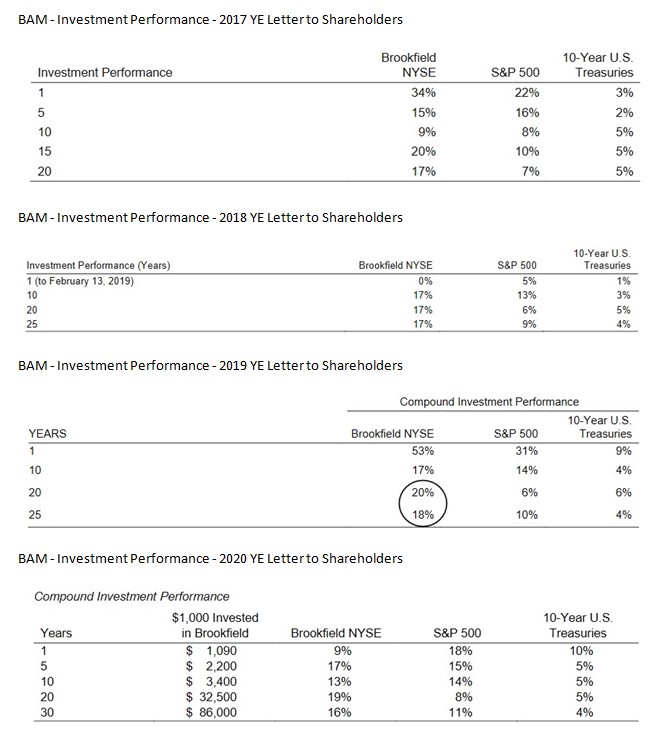
BAM - Investment Performance - 2017 - 2020 YE Letter to Shareholders
BAM's strong results are supported by growth in its asset management business and steady distributions from its principal investments.
The asset management business continues to grow with flagship funds growing in size. In addition, BAM is developing new products that are being well received by the market.
BAM uses multiple performance measures to more accurately disclose its performance and that of its underlying performance and its consolidated subsidiaries.
The following are 3 key performance measures BAM uses.
- Carried Interest (CI)
- Distributable Earnings (DE)
- Fund From Operations (FFO)
A more comprehensive description of each term and other metrics by which BAM gauges its performance is found in every interim quarterly report; the Q1 2021 Quarterly Report is currently the most current available. The glossary of terms commences on page 56 of 92.
Brookfield Asset Management - Stock Analysis - Recent Transactions
The following are a few of BAM's recent transactions.
Brookfield Oaktree Wealth Solutions
Individual investors, supported by the wealth channel, are dramatically underweight in alternatives, often with less than 3% of their portfolios in alternative assets.
On July 15, BAM and Oaktree Capital Management, L.P. announced they have agreed to transition the advisory role of Oaktree Real Estate Income Trust, Inc. to an affiliate of BAM with the Non-Traded REIT changing its name Brookfield Real Estate Income Trust Inc.
Brookfield REIT will be distributed by Brookfield Oaktree Wealth Solutions, a wealth management platform established to offer institutional-calibre alternative investment products to individual and high net worth investors globally. The team at recently formed Brookfield Oaktree Wealth Solutions is dedicated to growing and supporting the development of new investment structures to target wealth channels, such as this recently announced non-traded-REIT.
Brookfield REIT will own high occupancy de-risked assets with recurring cash flows. The plan is to fully launch a strategy by the end of 2021 and the flexibility provided by the privatization of Brookfield Property Partners (BPY) (see below for an overview of this privatization) will be instrumental to this launch and the forward business plan for this product.
BAM has identified mid-market institutions as a largely untapped segment of the investor market for the BAM group.
BAM's credit platform has had considerable success in the mid-market institutions segment and the plan is to build on this success with other funds. In addition, insurance companies are facing the challenge of ultra-low returns on their fixed-income portfolios. BAM has determined that alternative investments are one of the few options available through which insurance companies can aim for superior returns.
BAM currently manages close to $30B of private fund capital from insurance companies. The expectation is that this will increase significantly as Brookfield Oaktree Wealth Solutions continues designing regulation-friendly products for this target market.
Sale of Enwave by Brookfield Infrastructure (BIP)
On October 31, 2012, BIP completed the acquisition of The City of Toronto’s 43% interest and Borealis Infrastructure’s 57% interest in Enwave Energy Corporation. This acquisition represented BIP's first district energy investment. The sale price represented a ~$0.48B enterprise value for Enwave.
Subsequently, BIP has developed Enwave into the largest district energy system in North America. Through various asset management initiatives, Enwave now generates stable and predictable cash flows, has a unique and highly attractive investment profile, and is a global leader in sustainability.
On July 16, 2021, BIP announced the divestiture of 100% of Enwave through two separate transactions for total consideration of $4.1B. Enwave’s Canadian business was acquired by Ontario Teachers’ Pension Plan Board and IFM Investors on June 7, 2021, and Enwave’s U.S. business was acquired by QIC and Ullico on July 16, 2021.
Net proceeds to BIP are ~$1B and management states BIP has earned an internal rate of return (IRR) of over 30% on its investment and a multiple of invested capital of over 6 times.
Following the completion of this transaction, BIP's corporate liquidity totals ~$4B. These funds are to be used toward growth initiatives.
Inter Pipeline Ltd. Acquisition
On February 10, 2021, BIP together with its institutional partners announced its intention to pursue the privatization of Inter Pipeline Ltd (IPL) for CAD $16.50/share in a transaction valued at CAD $13.5B. Inter Pipeline has deemed this price to be well below the company's fair value and has strongly resisted BIP efforts to acquire the company.
On August 6, BIP announced that it has filed a fifth notice of variation and extension and has achieved an initial tender of ~52% of IPL's issued and outstanding shares. Under the terms of the takeover offer, IPL shareholders may elect up to 100% cash consideration, totalling CAD $20.00/share of IPL without being subject to proration or 0.250 of a class A exchangeable subordinated voting share of Brookfield Infrastructure Corporation.
Creation of BAM Reinsurance Partners
On June 28, BAM completed the previously announced creation of Brookfield Reinsurance.
Over the past decade, BAM has built a team to provide a wide range of capital and investment solutions to insurance companies globally. Through BAM's expertise, insurance companies have been able to acquire higher yield credit products through BAM's funds.
As rates reached current lows, BAM started acquiring direct books of business reinsuring asset-intensive life and annuity policies.
The creation of BAM Reinsurance Partners places greater focus on this business and is a more efficient structure. BAM's management states that its partnership approach to business, its investment capabilities, strong balance sheet and significant liquidity are key differentiators. This makes the BAM a good counterparty for insurers and particularly in this low-interest-rate environment. BAM also has a long successful track record in real estate, infrastructure and other lower-volatility, higher-returning credit strategies. These are a strategic competitive advantage when dealing with life and annuity-focused insurance companies.
BAM Reinsurance Partners to Acquire American National for $5.1B
On August 9, BAM announced the proposed acquisition of a 100% interest in American National (ANAT); a high-level overview of ANAT is provided in Part 1 of its FY2020 10-K.
ANAT has conducted business from its headquarters in Galveston, Texas since 1905. Its family of companies includes five life insurance companies, eight property and casualty insurance companies, and numerous non-insurance subsidiaries. The company operates in the following business segments:
- Life;
- Annuity;
- Property and Casualty;
- Health; and
- Corporate and Other.
ANAT is predominantly focused on life and annuities products with a smaller P&C business.
It manages ~$30B of assets and has a net asset value of just over $6B.
ANAT is being acquired for $5.1B with funding coming from $1.5B of nonrecourse debt and the balance from equity.
In ANAT, BAM has identified a company with an excellent management team, a conservative and prudent underwriting culture, and a long track record of stable earnings and capital management.
BAM will focus on enhancing profitability and lowering risks through its investment capabilities. This is achievable due to the significant credit products within BAM that are ideally suited to the broader insurance community due to their low volatility, stable returns, and capital efficiency.
These credit strategies are across real estate infrastructure and renewable power, where BAM has the expertise that has been further enhanced through the Oaktree partnership; BAM already has more than 100 insurers in North America and Europe as clients in these strategies.
BAM believes it can grow the net asset value meaningfully over the next 5 years through asset optimization and expansion into new lines of business. Examples include pension risk transfer and third-party reinsurance to ANAT.
Once the ANAT transaction closes, Brookfield Reinsurance will manage over $40B of reinsurance assets through a combination of BAM's pension business and the reinsurance transactions currently in place with several U.S. domestic insurers.
This merger is expected to close in the first half of 2022.
Privatization of Brookfield Property Partners (BPY)
In early January 2021, BAM formally agreed with the special committee of BPY to privatize BPY.
The tone in the market for commercial property assets was very negative and it was deemed that BAM would be able to do more with BPY’s assets if they were privately owned as opposed to what BPY could do with these assets under the constraints affecting a public entity. This privatization was completed on July 26, 2021.
Management expects the market for commercial property assets to improve over the years and this portfolio of assets could be spun-off at a later date. In the interim, BAM shareholders have the opportunity to participate in any improvement in the value of these assets.
Bruce Flatt, BAM's CEO, has indicated BAM has ~$30B of equity tied up in commercial real estate. The plan is to wring as much cash from these holdings in the coming years to fund new investments and to reap ~$25B from commercial property sales.
BAM deems roughly $16B of this real estate to be 'irreplaceable'. These are office and retail-anchored properties in major cities located mainly in New York and London. Historically they have tended to appreciate over time while providing steady cash flow. The intent is to hold these properties for the long term. However, BAM could sell stakes in these assets and refinance them as their valuations climb. This could free up ~$10B to fund other investments.
The remaining $14B of its properties are 'opportunistic investments' with a shorter investment time horizon of 5 - 7 years. The sale of these assets could generate additional funds for investment purposes.
Brookfield Global Transition Fund
On July 27, BAM announced an initial US$7B closing for the Brookfield Global Transition Fund (BGTF). This establishes BGTF as the largest fund focused on the global transition to a net-zero economy.
Brookfield Asset Management - Stock Analysis - Financials
Q2 2021 and YTD Results
I encourage you to read BAM's CEO's Q2 Letter to Shareholders!
Page 32 of 42 in the Q2 Supplemental Information package reflects total funds from operations of ~$1.6B, distributable earnings of ~$1.23B, and net income of ~$2.4B.
In BAM's asset management business, fee-bearing capital increased by $6B to $325B at the end of Q2; this is up by $48B over the last 12 months. This led to fee-related earnings of $0.483B for Q2 and $1.7B over the last 12 months representing a 25% increase from the prior periods.
$32B of additional committed capital will become fee-bearing once invested. This translates into ~$0.32B of incremental annual fee revenues.
BAM continues to execute capital recycling initiatives at favourable prices. It generated $8B of proceeds from monetization during Q2 that enabled it to return $6B to clients and to realize $0.335B of carried interest into income.
BAM has now realized over $1B of YTD gross carried interest. In doing so, it has reached the 2021 two-year target well ahead of schedule and more gross carried interest is expected over the balance of the year.
Investments performed very well in Q2. BAM generated over $1B of unrealized carried interest thus increasing the total accumulated unrealized carried interest by 20% to over $6B. BAM expects to recognize this into income over time as it continues to execute on asset sales.
On the Q2 earnings call, management pointed out that much of the accumulated unrealized carried interest is in earlier vintage funds which are much smaller than the current vintages.
The operating businesses continue to perform very well and some are specifically benefiting from the relaxing of COVID-related restrictions.
Distributable Earnings before realizations increased 35% over the last 12 months period. This increase is largely driven by the continued growth of the asset management franchise and increased distributions from affiliated companies.
Liquidity remains very strong with ~$78B of deployable capital.
After Q2, BAM further bolstered liquidity with $0.85B of debt instruments to take advantage of an attractive rate environment. Uses of the proceeds from the offering will be the financing of eligible green projects and general corporate purposes.
The balance sheet remains conservatively capitalized with 94% of debt having no recourse to BAM and a ~10% debt to market capitalization ratio. In combination with BAM's corporate balance sheet that has over $9B of core liquidity, $60B of investments and $3B of distributable earnings generated annually, BAM has a strong foundation to fund strategic acquisitions or to buy back shares.
Brookfield Asset Management - Stock Analysis - Credit Ratings
The senior unsecured domestic long-term debt ratings assigned by the major rating agencies are:
- S&P Global assigns an A- long-term unsecured debt credit rating with a stable outlook; and
- Fitch assigns an A- long-term unsecured debt credit rating;
- Moody's assigns Baa1 long-term unsecured debt credit rating with a stable outlook which is one level lower than Fitch's and S&P Global's ratings.
S&P Global's and Fitch's ratings are the lowest tier in the upper-medium-grade investment-grade tier. Moody's rating is the top tier within the lower-medium-grade investment-grade tier.
S&P Global and Fitch define BAM as having a STRONG capacity to meet its financial commitments. It is, however, somewhat more susceptible to the adverse effects of changes in circumstances and economic conditions than obligors in higher-rated categories.
Moody's defines BAM as having an ADEQUATE capacity to meet its financial commitments. However, adverse economic conditions or changing circumstances are more likely to lead to a weakened capacity to meet its financial commitments.
These ratings satisfy my conservative investment preferences.
Dividend and Dividend Yield
BAM distributes a quarterly dividend with the next USD $0.13/share quarterly distribution scheduled for September 29. With the US shares trading at ~$56, the dividend yield is just under 1%.
This low dividend yield will clearly not appeal to investors seeking an attractive dividend yield and dividend income. I, however, invest in BAM for its capital gains potential. I would much rather BAM retain funds to generate double-digit returns that far outpace the rate of inflation. Another advantage to BAM's retention of funds is the deferral of capital gains tax until the time of sale.
Although BAM does repurchase shares, we see an increase in the share count for FY2011 - FY2020 (in millions of shares): 1,469, 1,460, 1,433, 1,426, 1,464, 1,465, 1,470, 1,466, 1,488, and 1,511. The weighted average shares outstanding in Q2 including the dilutive effect of conversion of options and other share-based plans using the treasury stock method and exchangeable shares of affiliate (41.8 million shares) is 1,550.
I have no qualms about the increase in the number of outstanding shares as long as the undervalue of each share appreciates over the long term.
Brookfield Asset Management - Stock Analysis - Valuation
Some portfolio managers shy away from BAM because it is not an easy conglomerate to value.
In addition, BAM is continually making sizable acquisitions and divestitures and their frequency will most likely increase. As a result, earnings estimates can quickly become outdated.
The following table reflects the disparity between Net Income (GAAP) and FFO.
We readily see that Net Income (GAAP) can fluctuate widely YoY. Meanwhile, the variance in FFO during the FY2016 - FY2020 timeframe is not nearly as pronounced. This is because FFO accounts for activities that are part of BAM's normal course of business. GAAP, however, does not.
The following Financial Profile helps investors understand how management views BAM's value.
We see that as at the end of Q2 2021, BAM's management viewed the per-share value to be $67.28. Management states these plan values are for illustrative purposes only and are not intended to forecast or predict future events, or measure intrinsic value. Investors must also consider that various recent transactions (see above) have occurred after Q2. The value reflected above should, therefore, only be used as a rough estimate of BAM's Net Asset Value per Share.
In my opinion, BAM's current USD ~$56.70 and CDN ~$71 share prices are attractive.
Brookfield Asset Management - Stock Analysis - Final Thoughts
I have no interest in investing in cryptocurrencies, SPACs, or complex derivative products. I do, however, want exposure to alternative assets thus my reason for investing in BAM.
As BAM expands its pool of investors and attracts increasingly large sums of money for deployment, I envision the magnitude and frequency of acquisitions and divestitures will accelerate. Since GAAP earnings do not account for such transactions, investors should focus on:
- FFO;
- Distributable Earnings; and
- Carried Interest
and other key metrics upon which BAM's management relies to gauge performance.
Fortunately, many investors rely heavily/exclusively on stock screeners; these stock screeners do not accurately reflect BAM's true picture.
In addition, many investors exclude BAM as a potential investment because of its sub 1% dividend yield.
Past performance does not predict how an investment will perform going forward. I, however, envision attractive investment returns from BAM going forward.
As a BAM shareholder since February 12, 2009, I can attest to the attractive investment return.
In my FFJ Portfolio – June 2021 Report, I disclose the sale of BAM shares held in one of the 'Side' accounts following tax planning sessions with our tax accountant. I have now acquired additional BAM shares through 2 'Core' accounts within the FFJ Portfolio to partially replace those sold. In addition, I acquired additional BAM shares for one of the young investors I am helping create an investment portfolio.
Stay safe. Stay focused.
I wish you much success on your journey to financial freedom!
Note: Please send any feedback, corrections, or questions to [email protected].
Disclosure: I am long BAM.
Disclaimer: I do not know your individual circumstances and do not provide individualized advice or recommendations. I encourage you to make investment decisions by conducting your own research and due diligence. Consult your financial advisor about your specific situation.
I wrote this article myself and it expresses my own opinions. I do not receive compensation for it and have no business relationship with any company mentioned in this article.


